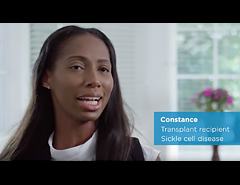What is a marrow or blood stem cell transplant?
Healthy blood stem cells are needed to live. When disease affects marrow so that it cannot function properly, a blood stem cell transplant could be the best treatment option, and for some patients, offers the only potential cure.
A blood stem cell transplant takes a donor’s healthy blood-forming cells and puts them into the patient’s bloodstream, where they begin to grow and make healthy red blood cells, white blood cells and platelets. Patients receive high doses of chemotherapy to prepare their body for the transplant. Then on transplant day, the patient receives the donated cells in a process that is like getting blood or medicine through an intravenous (IV) catheter, or tube.
Where do healthy cells come from?
 Watch patients and transplant experts explain the basics of bone marrow transplant.
Watch patients and transplant experts explain the basics of bone marrow transplant.
Cells can be donated from someone else—either from an adult donor or a cord blood unit stored for public use, or a patient may be able to use their own blood-forming cells.
An autologous transplant is when a person’s own cells are used. These cells are collected from the patient’s bloodstream and stored for transplant. Autologous transplant may be an option for patients with certain diseases.
An allogeneic transplant is when cells from a family member, unrelated donor or umbilical cord blood unit are used for transplant. This is also called a related donor transplant if the donor is a family member or an unrelated donor transplant if the donor is not a family member.
Depending on a patient’s disease and health status their doctor may recommend an autologous or an allogeneic transplant.
70% of patients do not have a fully matched donor in their family. So their doctor will turn to NMDP for help finding an unrelated donor or cord blood unit on the NMDP Registry. More people are needed to join the registry so patients have a greater chance of finding a match. Joining the donor registry is the first step to become a bone marrow donor.
Diseases treatable by transplant
Find out what diseases are treatable with a bone marrow or umbilical cord blood transplant.
Replacing diseased cells with healthy ones
These cells can come from three sources:
- Bone marrow
- Peripheral (circulating) blood (also called peripheral blood stem cells or PBSC)
- Blood collected from an umbilical cord after a baby is born
Doctors will choose the best source of cells for a patient. We only use cells voluntarily donated by either an adult donor, or cells collected from the umbilical cord, which occurs only after a full-term delivery where both mother and baby are healthy and safe.
